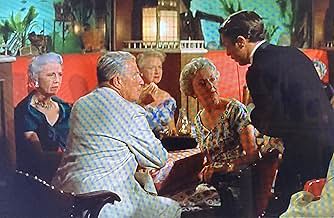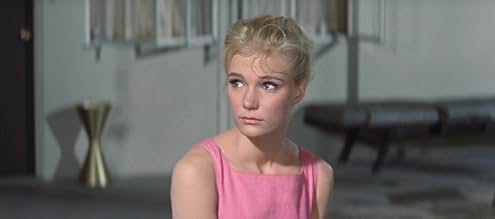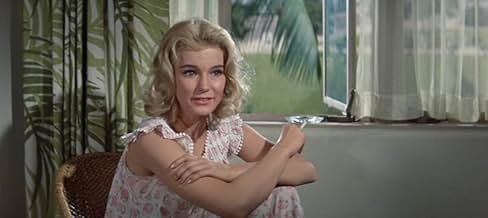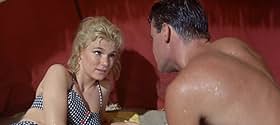ÉVALUATION IMDb
6,7/10
3,3 k
MA NOTE
Quatre étudiantes très différentes se rendent à Fort Lauderdale pour les vacances de printemps et partent à la recherche d'aventures et de romances.Quatre étudiantes très différentes se rendent à Fort Lauderdale pour les vacances de printemps et partent à la recherche d'aventures et de romances.Quatre étudiantes très différentes se rendent à Fort Lauderdale pour les vacances de printemps et partent à la recherche d'aventures et de romances.
- Director
- Writers
- Stars
- Prix
- 2 nominations au total
Carol Byron
- Sybil
- (uncredited)
John Cliff
- Policeman at Hospital
- (uncredited)
Oliver Cross
- Nightclub Patron
- (uncredited)
Jack Deery
- Nightclub Patron
- (uncredited)
Amy Douglass
- Dr. Raunch
- (uncredited)
Dennis Durney
- Young Man
- (uncredited)
Avis en vedette
Like many others who have commented previously on Where the Boys Are (WTBA), I was initially rather shocked at the film's frank discussion of sex. Once I thought about it more deeply, however, it was the open talk of marriage that was really fresh to my ears. I was born 11 years after this film was released and watching movies like this gives me a unique insight into history that goes well beyond the broad brushes of most sixties reviews and textbooks. Clearly both boys and girls of the time were struggling with the implications of sexuality in relationships - not a whole lot different than today.
What is different about WTBA than the films for young people of today or of my youth (e.g., The Breakfast Club) is the explicit discussion of marriage. In WTBA both the girls and the boys use different levers to try to achieve their ends. The girls use the potential for sex to get the one thing they want - marriage - and the boys use the potential for marriage to get what they are after - sex. I was amazed to hear that all the girls (even the one with an IQ of 138!) were so focussed on catching a husband at 19. None of the movies for youth that I have seen recently even touch the subject of marriage except maybe to joke about it.
While many would argue that no one gets married at 19 anymore, that ultimate end of any relationship still looms out there for young people like a giant prize (or punishment) at the end of dating. The only help I got in seeing young people get together and eventually get married was in The Princess Bride, which could easily be dismissed as fairy tale. I recall in my late teens having to turn to more adult movies like When Harry Met Sally or even Enchanted April to find some guidance for seeing a relationship through to its logical end. Maybe today's youth are skipping over She's All That and going to movies like High Fidelity for similar answers. One would hope so.
So instead of a breezy beach movie I got a social history lesson on the mating rituals of my parents' generation. I hope there's a movie that prompts this kind of discussion for my own kids someday.
What is different about WTBA than the films for young people of today or of my youth (e.g., The Breakfast Club) is the explicit discussion of marriage. In WTBA both the girls and the boys use different levers to try to achieve their ends. The girls use the potential for sex to get the one thing they want - marriage - and the boys use the potential for marriage to get what they are after - sex. I was amazed to hear that all the girls (even the one with an IQ of 138!) were so focussed on catching a husband at 19. None of the movies for youth that I have seen recently even touch the subject of marriage except maybe to joke about it.
While many would argue that no one gets married at 19 anymore, that ultimate end of any relationship still looms out there for young people like a giant prize (or punishment) at the end of dating. The only help I got in seeing young people get together and eventually get married was in The Princess Bride, which could easily be dismissed as fairy tale. I recall in my late teens having to turn to more adult movies like When Harry Met Sally or even Enchanted April to find some guidance for seeing a relationship through to its logical end. Maybe today's youth are skipping over She's All That and going to movies like High Fidelity for similar answers. One would hope so.
So instead of a breezy beach movie I got a social history lesson on the mating rituals of my parents' generation. I hope there's a movie that prompts this kind of discussion for my own kids someday.
This film succeeds in the sense that it isn't a stereotypical beach flick. As a current college student, I can attest that it is rather believable, and, oddly enough, some of it applies to college gals today...nearly 40 years later. Actually, WHERE THE BOYS ARE offers the public a fairly realistic, in-depth portrayal of everyday kids in the 60s, as opposed to other beach movies of the period. Simply put: Frankie and Annette had nothing on these gals!
Contrary to what the title may lead one to believe, the focal point is not terribly superficial. Yeah, sure, the girls head to Lauderdale to nab a Yaley or two, but that becomes somewhat secondary to what actually transpires. Whether it was meant to be or not, this film is one of decisions, learning, and friendships that are strengthened due to the experiences four college girls share during Spring Break in Ft. Lauderdale.
The actors themselves are very believable; none of the main players outdo the others. Hart, Mimeux, Francis, and Prentiss do a wonderful job of conveying many different sides to the characters they portray. The supporting cast is equally skilled and effective in varying roles.
Though this isn't Academy Award winning material, it is definitely worth watching!
Contrary to what the title may lead one to believe, the focal point is not terribly superficial. Yeah, sure, the girls head to Lauderdale to nab a Yaley or two, but that becomes somewhat secondary to what actually transpires. Whether it was meant to be or not, this film is one of decisions, learning, and friendships that are strengthened due to the experiences four college girls share during Spring Break in Ft. Lauderdale.
The actors themselves are very believable; none of the main players outdo the others. Hart, Mimeux, Francis, and Prentiss do a wonderful job of conveying many different sides to the characters they portray. The supporting cast is equally skilled and effective in varying roles.
Though this isn't Academy Award winning material, it is definitely worth watching!
i don't understand how anyone cannot like this film! the story about the 4 co-eds is mind-grabbing but i couldn't help wondering if all that sex talk would be looked upon well, it being the good old sixties. i would descibe this film as smooth, quirky, dramatic, and fun. i am a HUGE fan of frank gorshin and i loved his portrayl of basil. the whole cast was was very good and that made it a great film. i usually rent this film at least once a month. but am i the only one who adores basil's glasses?
To be honest, the movie began as a typical- and not so great, teenage comedy flick, in which a couple of youngsters are going on a spring break holiday. "Where the Boys Are" however handles delicate themes delicately and the movie is way more than just another teenage comedy.
Actually quite amazing considering that this movie got made in 1960. The movie and its theme seems far ahead of its time. It makes the movie all the more relevant for the time period it got released in and all the more interesting now days to watch. This movie is basically a good observation of how teenagers handled sexual themes in 1960, without ever getting raunchy or not honest. It's a straightforward flick with its theme but its style ensures that this movie at all times mostly remains an entertaining and light one to watch. The movie also really doesn't feel like it was made in 1960.
It's an all the more interesting movie since it tells the story from the viewpoint of the female characters, which works refreshing for a change.
The movie knows to create a perfect balance between its more serious moments and its entertainment value. With movies like this the drama would often feel forced and out of place since the entire movie is done in a comical style of film-making. The creators of this movie however managed to find the right balance, without ever crossing any lines.
Above all things it's still a very entertaining movie to watch. It's still mostly a comedy that provides some good entertainment and has some likable characters in it.
The characters are also really a reason why the movie works out. Lot of the characters are very stereotypical but luckily the actors don't go over-the-top with their roles, which ensures that we can also really start to like- and feel for some of the characters.
The acting was way better than expected. Paula Prentiss really impressed me, also with her beauty and the movie further more features George Hamilton and Frank Gorshin in some early roles. Gorshin is still perhaps best known for his portrayal of the Riddler in the early "Batman" series.
A surprising and fresh movie that deserves to be seen by more.
7/10
http://bobafett1138.blogspot.com/
Actually quite amazing considering that this movie got made in 1960. The movie and its theme seems far ahead of its time. It makes the movie all the more relevant for the time period it got released in and all the more interesting now days to watch. This movie is basically a good observation of how teenagers handled sexual themes in 1960, without ever getting raunchy or not honest. It's a straightforward flick with its theme but its style ensures that this movie at all times mostly remains an entertaining and light one to watch. The movie also really doesn't feel like it was made in 1960.
It's an all the more interesting movie since it tells the story from the viewpoint of the female characters, which works refreshing for a change.
The movie knows to create a perfect balance between its more serious moments and its entertainment value. With movies like this the drama would often feel forced and out of place since the entire movie is done in a comical style of film-making. The creators of this movie however managed to find the right balance, without ever crossing any lines.
Above all things it's still a very entertaining movie to watch. It's still mostly a comedy that provides some good entertainment and has some likable characters in it.
The characters are also really a reason why the movie works out. Lot of the characters are very stereotypical but luckily the actors don't go over-the-top with their roles, which ensures that we can also really start to like- and feel for some of the characters.
The acting was way better than expected. Paula Prentiss really impressed me, also with her beauty and the movie further more features George Hamilton and Frank Gorshin in some early roles. Gorshin is still perhaps best known for his portrayal of the Riddler in the early "Batman" series.
A surprising and fresh movie that deserves to be seen by more.
7/10
http://bobafett1138.blogspot.com/
Forty-five years have elapsed since its original release, but it is amazing how this 1960 film introduced a particular genre that continues to be produced today granted in a far more explicit manner - the spring-break, beach-party movie where attractive teens go through a sun-drenched mating ritual and somehow love triumphs over carnal knowledge. Back then, the concept didn't seem quite as jaded as it does now, and consequently there is an entertaining naiveté about the timeworn story of four co-eds from a snowy Midwestern college who journey to Ft. Lauderdale for spring break to meet boys.
The plot is based on the then-accepted notion that girls in college are only marking time waiting for husbands to come along, but the journey to that goal depends on the girl. The four in question are Merritt, a smart blonde who is not living up to her academic potential as she questions the moral code around premarital sex; Melanie, so deeply insecure she mistakes sex for love with a less-than-honorable Ivy Leaguer; Tuggle, a tall brunette who zeroes in on an even taller, eccentric hitchhiker; and Angie, the supposedly plain one who gets used to being ignored by men.
Directed in a perfunctory fashion by Henry Levin, this is not the type of movie where you are terribly impressed with the performances, but I have to say the acting is certainly miles above subsequent beach-party movies. Elvis' former leading lady Dolores Hart plays Merritt credibly even as she is being seduced by a youthful George Hamilton wanly playing Ryder, a well-to-do Ivy Leaguer with a conveniently located yacht. As the most troubled of the girls, Yvette Mimieux (always loved her name) accurately captures the constantly forlorn, little-girl-lost state of Melanie, a teen-aged Blanche du Bois in the making.
So pert and charming as Angie, Connie Francis actually seems miscast as a plain-Jane, especially when she sings "Turn on the Sunshine" with a stage polish completely out of character. The standout is Paula Prentiss who portrays Tuggle with her unique personality in full bloom and partnered the first of several times with Jim Hutton as the comically obnoxious TV. She is an under-appreciated comedienne with a loopy charm and vibrantly twangy voice all her own - it's a shame her career never really took off the way it deserved to.
I think the film does make a valid, sometimes even perceptive attempt to address the confusion that Eisenhower-era girls had over sex and love. Girls were expected to function under a double-standard where the only way to attract boys was to have something to offer but at the price of their reputations. This point is hammered home when the tone shifts in the last portion to melodrama. At the same time, the film is filled with predictable comic scenes, including a contrived mêlée in an underwater tank with the zaftig and nasal Barbara Nichols as Esther Williams-wannabe Lola Fandango.
Prentiss offers her services and remembrances to the alternate audio commentary track on the DVD, which also comes with a looking-back featurette which includes interviews with Prentiss and Francis. Who knew this film would launch a hundred imitations? The minute you hear Francis sing the title tune, it is hard for a baby boomer not to get nostalgic. If you have an interest in understanding the mid-century moral code enforced upon the youth of America, especially girls, I can think of worse films to see.
The plot is based on the then-accepted notion that girls in college are only marking time waiting for husbands to come along, but the journey to that goal depends on the girl. The four in question are Merritt, a smart blonde who is not living up to her academic potential as she questions the moral code around premarital sex; Melanie, so deeply insecure she mistakes sex for love with a less-than-honorable Ivy Leaguer; Tuggle, a tall brunette who zeroes in on an even taller, eccentric hitchhiker; and Angie, the supposedly plain one who gets used to being ignored by men.
Directed in a perfunctory fashion by Henry Levin, this is not the type of movie where you are terribly impressed with the performances, but I have to say the acting is certainly miles above subsequent beach-party movies. Elvis' former leading lady Dolores Hart plays Merritt credibly even as she is being seduced by a youthful George Hamilton wanly playing Ryder, a well-to-do Ivy Leaguer with a conveniently located yacht. As the most troubled of the girls, Yvette Mimieux (always loved her name) accurately captures the constantly forlorn, little-girl-lost state of Melanie, a teen-aged Blanche du Bois in the making.
So pert and charming as Angie, Connie Francis actually seems miscast as a plain-Jane, especially when she sings "Turn on the Sunshine" with a stage polish completely out of character. The standout is Paula Prentiss who portrays Tuggle with her unique personality in full bloom and partnered the first of several times with Jim Hutton as the comically obnoxious TV. She is an under-appreciated comedienne with a loopy charm and vibrantly twangy voice all her own - it's a shame her career never really took off the way it deserved to.
I think the film does make a valid, sometimes even perceptive attempt to address the confusion that Eisenhower-era girls had over sex and love. Girls were expected to function under a double-standard where the only way to attract boys was to have something to offer but at the price of their reputations. This point is hammered home when the tone shifts in the last portion to melodrama. At the same time, the film is filled with predictable comic scenes, including a contrived mêlée in an underwater tank with the zaftig and nasal Barbara Nichols as Esther Williams-wannabe Lola Fandango.
Prentiss offers her services and remembrances to the alternate audio commentary track on the DVD, which also comes with a looking-back featurette which includes interviews with Prentiss and Francis. Who knew this film would launch a hundred imitations? The minute you hear Francis sing the title tune, it is hard for a baby boomer not to get nostalgic. If you have an interest in understanding the mid-century moral code enforced upon the youth of America, especially girls, I can think of worse films to see.
Le saviez-vous
- AnecdotesPaula Prentiss signed a seven-year contract with MGM in 1960 when she was cast in this movie. She was living with boyfriend actor Richard Benjamin at the time, which was taboo in those days, and the studio didn't want her traveling on promotion junkets with a man who wasn't her spouse. So they asked the two to wed, though not before milking the wedding for publicity. Prentiss had to make long-distance calls to gossip columnists Hedda Hopper and Louella Parsons just before the ceremony, according to People. They were married by a New York judge on Oct. 26, 1961. They are still together as of 2022.
- GaffesWhen the kids are first introduced to Basil's jazz band, hundreds of kids rush to the bar, with the main characters in the rear. Yet, the main characters somehow manage to find one of the few tables in the bar.
- Citations
Police Captain: Wait a minute! Haven't I seen you in here before?
Lola Fandango: Just once, and it was purely by accident. The night my strap broke?
[she shows her very revealing top]
- Générique farfelu"and introducing Connie Francis"
- ConnexionsFeatured in Where the Boys Were: A Retrospective (2004)
- Bandes originalesWhere the Boys Are
Words by Howard Greenfield
Music by Neil Sedaka
Performed by Connie Francis (uncredited)
Courtesy of Nevins - Kirshner
Meilleurs choix
Connectez-vous pour évaluer et surveiller les recommandations personnalisées
- How long is Where the Boys Are?Propulsé par Alexa
- What is 'Where the Boys Are' about?
- Is 'Where the Boys Are' based on a book?
- How does the movie end?
Détails
- Date de sortie
- Pays d’origine
- Sites officiels
- Langue
- Aussi connu sous le nom de
- Where the Boys Are
- Lieux de tournage
- Fort Lauderdale, Floride, États-Unis(some exteriors)
- société de production
- Consultez plus de crédits d'entreprise sur IMDbPro
- Durée1 heure 39 minutes
- Rapport de forme
- 2.35 : 1
Contribuer à cette page
Suggérer une modification ou ajouter du contenu manquant

Lacune principale
By what name was Ces folles filles d'Ève (1960) officially released in India in English?
Répondre





























